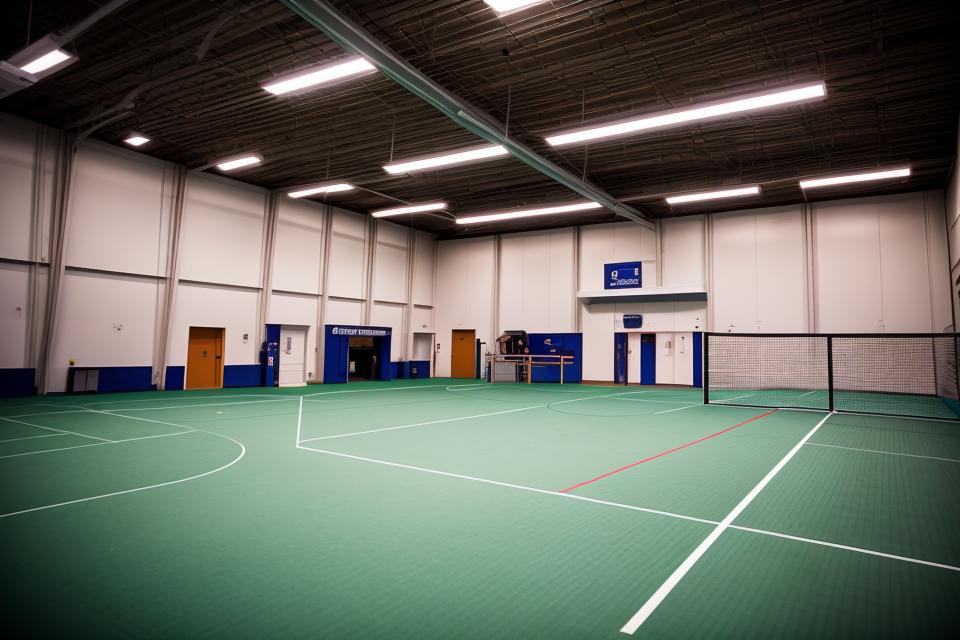Squash, once a beloved sport among many, has seen a decline in its popularity in recent years. Despite its many benefits, including excellent cardiovascular exercise and a fun, social atmosphere, squash clubs in Japan are struggling to attract new members. This raises the question: why has squash lost its appeal? In this examination, we will explore the potential reasons behind this decline in popularity and investigate how squash clubs in Japan are working to keep the sport alive. Whether it’s due to changing interests or a lack of exposure, we will dive into the factors that may be contributing to the sport’s waning popularity and explore possible solutions for reviving its appeal.
Decline in Squash Participation
Factors Contributing to the Decline
- Increased competition from other sports
- The rise of other sports, such as soccer and basketball, has drawn attention away from squash, making it a less desirable option for many young athletes.
- Additionally, the increasing popularity of team sports has led to a decline in individual sports like squash.
- Limited accessibility to squash facilities
- Many potential squash players may not have access to a squash court, either due to geographic barriers or lack of facilities in their area.
- This lack of accessibility can make it difficult for individuals to try the sport and become invested in it.
- Changing demographics and interests of the younger generation
- As the younger generation grows up, their interests and priorities may shift away from squash, leading to a decline in participation rates.
- This can be attributed to a variety of factors, such as changing social norms, economic conditions, and cultural influences.
- For example, the younger generation may be more interested in sports that are seen as more exciting or glamorous, such as football or tennis.
Decrease in Squash Club Memberships
Reduced membership numbers in squash clubs
One of the primary reasons for the decline in squash participation is the reduction in membership numbers in squash clubs. This trend has been observed across many countries, but it is particularly pronounced in Japan. In recent years, the number of squash club memberships has declined significantly, resulting in a reduction in the overall popularity of the sport.
Aging population of club members
Another factor contributing to the decline in squash participation is the aging population of club members. Many of the current club members are in their 40s and 50s, and as they retire or reduce their participation in the sport, there are fewer younger players to replace them. This lack of new blood in the sport has resulted in a stagnation of the player base, with few new players joining the ranks.
Insufficient efforts to attract new members
Finally, a lack of efforts to attract new members has also contributed to the decline in squash participation. Many squash clubs in Japan have failed to implement effective marketing strategies or to offer attractive programs to entice new players to join. This has resulted in a stagnation of the player base, with few new players joining the ranks.
Overall, the decline in squash club memberships is a significant factor in the decline of squash participation in Japan. Without a concerted effort to attract new players and to retain existing ones, the sport risks losing its popularity and becoming a niche activity.
Squash Clubs in Japan
History of Squash in Japan
- Introduction of squash to Japan
- Squash was first introduced to Japan in the 1970s through the efforts of a group of American expatriates who had a passion for the sport. They built the first squash court in Japan, which was located in Tokyo, and began to promote the sport through tournaments and exhibitions.
- Over time, the popularity of squash grew, and more courts were built in various parts of the country. This led to the formation of squash clubs, which provided a venue for players to train and compete.
- Growth of squash as a sport in Japan
- During the 1980s and 1990s, squash experienced a significant increase in popularity in Japan. This was due in part to the success of Japanese players on the international stage, including the achievements of players such as Michihiko Ohta and Shigeru Kawasaki.
- Additionally, the establishment of the Japan Squash Association in 1987 helped to promote the sport and increase its visibility. The association organized tournaments and events, and provided support for the development of squash programs at schools and universities.
- However, despite this growth, the sport has seen a decline in popularity in recent years. Factors contributing to this decline include the rise of other sports, changes in demographics, and a lack of investment in the sport’s infrastructure.
Current State of Squash Clubs in Japan
Number of Squash Clubs in Japan
In recent years, the number of squash clubs in Japan has been on the decline. According to a survey conducted by the Japan Squash Association, there were approximately 250 squash clubs in Japan in 2018, down from 300 in 2013. This decline in the number of clubs has been attributed to a variety of factors, including changes in demographics, the popularity of other sports, and economic factors.
Location and Accessibility of Squash Clubs
The location and accessibility of squash clubs in Japan have also contributed to the decline in popularity of the sport. Many of the existing clubs are located in urban areas, making it difficult for people in rural areas to access them. Additionally, many of the clubs are located in expensive real estate areas, which makes it difficult for people to afford the membership fees.
Facilities and Equipment Available in Squash Clubs
Another factor that has contributed to the decline in popularity of squash in Japan is the condition of the facilities and equipment available in the clubs. Many of the clubs are old and in need of renovation, which can make playing the sport unpleasant for players. Additionally, some clubs do not have enough courts or equipment, which can lead to overcrowding and long wait times for players.
In conclusion, the current state of squash clubs in Japan is a cause for concern, as the decline in the number of clubs, location and accessibility, and facilities and equipment available has contributed to the decline in popularity of the sport. To address these issues, it is important for the Japan Squash Association to work with the government and private sector to promote the sport and improve the infrastructure for playing squash in Japan.
Challenges Faced by Squash Clubs in Japan
- Limited resources and funding for squash clubs
- Squash clubs in Japan often struggle to secure adequate funding to maintain and improve their facilities, leading to a lack of investment in equipment, technology, and coaching staff.
- Limited resources can also hinder the development of new programs and initiatives aimed at attracting and retaining members, ultimately impacting the overall growth and sustainability of the sport.
- Difficulty in attracting and retaining members
- With a growing range of sports and leisure activities available to the public, squash clubs in Japan face intense competition for members and struggle to maintain their appeal.
- To attract new members, squash clubs often offer promotional discounts, trial periods, and other incentives, but these efforts may not be enough to retain members in the long term.
- The high cost of membership fees and additional expenses, such as court rental fees, can also deter potential members from joining squash clubs.
- Competition from other sports and leisure activities
- Squash clubs in Japan face increasing competition from other sports and leisure activities, such as tennis, badminton, and swimming, which also offer similar physical and social benefits.
- The popularity of these alternative activities can draw potential members away from squash clubs, making it difficult for them to maintain their membership base.
- Moreover, the rise of virtual sports and online gaming has created new forms of entertainment that may appeal to younger generations, further impacting the popularity of squash clubs.
Future of Squash in Japan
Revitalizing Squash Clubs in Japan
Implementing Marketing and Outreach Programs
- Partnering with local schools and community centers to introduce squash to a younger audience
- Creating social media campaigns and online content to promote the sport and increase visibility
- Hosting open houses and demo days to allow potential members to try the sport for free
Upgrading Facilities and Equipment
- Investing in new technology and equipment to improve the quality of play and training
- Improving lighting and court conditions to create a more enjoyable playing experience
- Offering a wider range of racquets and equipment to accommodate players of all levels
Offering Unique and Engaging Programs for Members
- Creating leagues and tournaments for players of all skill levels
- Offering fitness and conditioning classes in addition to squash training
- Hosting social events and gatherings to foster a sense of community among members
- Introducing new formats such as doubles and mixed doubles to keep the sport fresh and exciting
- Encouraging teamwork and collaboration through partner drills and games
- Providing opportunities for members to give back to the community through volunteer events and outreach programs.
Potential for Growth in Squash Popularity
- Expansion of squash into new markets
- Targeting younger demographics through school and university programs
- Promoting squash as a healthy and enjoyable activity for all ages
- Creating partnerships with local sports organizations to increase exposure and participation
- Integration with other sports and physical activities
- Collaborating with other sports to create cross-training opportunities
- Organizing joint events and tournaments to attract new players
- Incorporating elements of other sports into squash to make it more appealing to a wider audience
- Development of a strong and supportive squash community in Japan
- Establishing a network of squash clubs and facilities across the country
- Providing opportunities for players to connect and socialize through events, leagues, and online platforms
- Encouraging mentorship and coaching programs to help develop the next generation of players
By focusing on these areas of potential growth, squash in Japan can build a stronger foundation for the future and re-establish its place as a popular and respected sport in the country.
FAQs
1. What is squash?
Squash is a racquet sport that is played by two players in a four-walled court. The players use a small, hollow rubber ball and a racquet to hit the ball back and forth across the court. The goal of the game is to outmaneuver your opponent and hit the ball in such a way that they cannot return it.
2. Why was squash popular in the past?
Squash was popular in the past because it was seen as a sport that could be played by people of all ages and skill levels. It was also seen as a sport that provided a good workout and was a good way to relieve stress. In addition, squash was popular in Japan in the 1980s and 1990s due to the success of Japanese players on the international stage.
3. Why has squash lost its popularity?
There are several reasons why squash has lost its popularity. One reason is that other sports have become more popular, such as soccer and basketball. In addition, the cost of playing squash, including the cost of a court and equipment, has become prohibitive for some people. Finally, the lack of opportunities to play squash, including the closure of some squash clubs, has also contributed to the decline in popularity of the sport.
4. Are there any squash clubs left in Japan?
Yes, there are still squash clubs in Japan, but they are not as numerous as they were in the past. Many of the squash clubs that were once popular have closed due to a lack of interest and the high cost of maintaining a court. However, there are still some dedicated squash players in Japan who continue to play the sport at a high level.
5. Is there any hope for the future of squash in Japan?
While the future of squash in Japan may seem uncertain, there are some signs of hope. The Japan Squash Federation has taken steps to promote the sport and encourage more people to play. In addition, some squash clubs have been successful in attracting new members by offering lower prices and providing a more welcoming environment for beginners. If these efforts are successful, it is possible that squash could once again become a popular sport in Japan.










